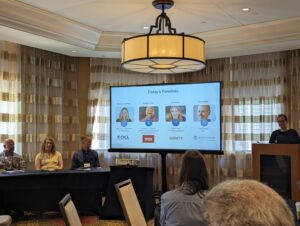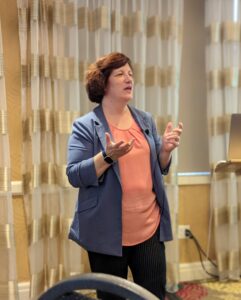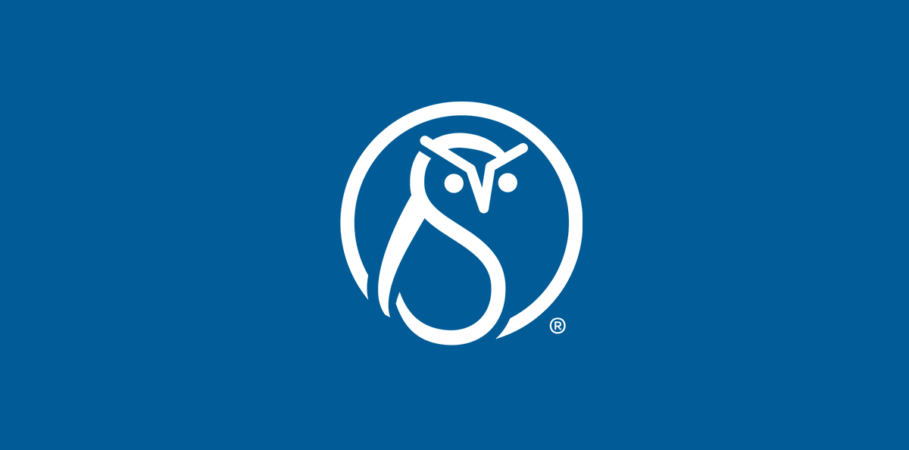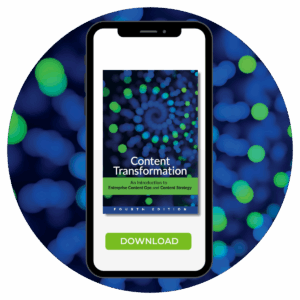Lightbulb moments from ConVEx
If you didn’t see our team in action at ConVEx this year, here are the highlights from our sessions.
Reality Check: Considerations beyond the CCMS
Hosted by Marianne Calilhanna from DCL, featuring Alan Pringle (Scriptorium) Carrie Hane (Sanity), and Jonathan Chandler (Intralox).
In this panel, each participant assumed the role of a participant in the typical CCMS selection process:
- Service provider: Marianne Calilhanna
- System user: Jonathan Chandler
- Architect: Carrie Hane
- Consultant: Alan Pringle
Throughout the panel, each participant shared the unique perspective of their role in the context of selecting a component content management system (CCMS).
Seated from left to right, Jonathan Chandler, Carrie Hane, and Alan Pringle. Standing, Marianne Calilhanna.
Before Intralox introduced content structure in their organization, Jonathan and his team did as much as possible to streamline their content operations by creating term definitions and content templates. They knew they needed a bigger solution, but they had no support from IT or management.
Jonathan: “It was a struggle explaining to management what we needed. They didn’t care about function, they cared about cost. We finally demonstrated [the financial impact] by using a 4-year chart analysis with projected savings and ROI.”
Jonathan: “It was a struggle explaining to management what we needed. They didn’t care about function, they cared about cost. We finally demonstrated [the financial impact] by using a 4-year chart analysis with projected savings and ROI.”
They estimated that structured content would cut translation costs to $500,000 in the first year, then $275,000 in the following years. Once that analysis was shared, management was ready to talk about structured content.
What’s better for cross-enterprise content?
The panel engaged in a lively discussion discussing which option is better for cross-enterprise content: XML/DITA or “content as data”?
Alan: “People in marketing, support, learning and education have used XML and DITA very successfully, so it can be done. But, I think we can agree: semantic, modular content is really the foundational key, we’re just approaching those from slightly different angles.”
Alan: “People in marketing, support, learning and education have used XML and DITA very successfully, so it can be done. But, I think we can agree: semantic, modular content is really the foundational key, we’re just approaching those from slightly different angles.”
Future-proofing your content
With the future ever in mind, the panelists shared these insights for protecting your content assets.
Carrie: “Content modeling and content strategy give you the ability to ‘think beyond’ the initial use of your content. They help you use the motive and intent of your content, which is also great for SEO.”
Carrie: “Content modeling and content strategy give you the ability to ‘think beyond’ the initial use of your content. They help you use the motive and intent of your content, which is also great for SEO.”
Alan: “Using a merger as an example — you don’t know what’s going to happen! Start with the exit in mind and always create an exit strategy, almost like a prenup, when you start working with a new CCMS.”
Alan: “Think through as many scenarios as possible. Take lottery winners as an example. They blow their money, and you think, ‘Why didn’t you hire an accountant or lawyers?’ It’s the ultimate change management problem.” This is not about merely getting a budget for technology. The system is not going to stand up itself, create your content model, or win hearts and minds on its own.
Value of content strategy
Though the panel had varied perspectives on other topics, they all agreed that content strategy is an integral part of any content solution.
Jonathan: “Hiring a consultant was worth more than the tools. Having them come in and lead with experience, and then train the team in the process was invaluable.”
Carrie: “Consultants help people imagine things they didn’t know — you can’t know what you don’t know. They help you achieve greater success faster.”
Alan: “As the client, you know where the bodies are buried in your company, where all the bad things are that need to be fixed. As a consultant, I know where the bodies are buried in the various systems. When you combine those two things, you get a very interesting graveyard, and then you also get a really good synergy because you’re coming at it from two different angles.”
Alan: “As the client, you know where the bodies are buried in your company, where all the bad things are that need to be fixed. As a consultant, I know where the bodies are buried in the various systems. When you combine those two things, you get a very interesting graveyard, and then you also get a really good synergy because you’re coming at it from two different angles.”
The Cost of (Content) Maturity
Sarah O’Keefe, Scriptorium
In this session, Sarah walked us through the growing pains that the content industry has experienced over the years as content operations have matured, and why we need to consider this as we eagerly look at new content innovations.
Some content groups, *cough* marketing *cough* are ready to go all-in and use knowledge graphs to drive content operations. Though knowledge graphs are intriguing and will open up exciting new possibilities, the implementation will come with challenges, just as every stage of content maturity has before it.
“Some are asking, ‘How do we move through the [content maturity] steps? Is there a way to skip these steps?’ Well, no!”
Before we jump into knowledge graphs, Sarah pointed out, we have to recognize where we’ve come from and how far our organization actually is along the content maturity scale. Otherwise, we’ll be leaping too far without a place to land.
“With all good growth, there are growing pains. As our content structure matures and processes get better, our pain in adjusting gets bigger, too.”
“With all good growth, there are growing pains. As our content structure matures and processes get better, our pain in adjusting gets bigger, too.”
To further explain how content “pain = gain” (or more specifically, there’s no gain without pain), Sarah guided us through the evolution of content structure, from “crap on a page” to “content in a database.”
As you move forward into the next phase of content maturity, you first have to know three things:
- How far you’re moving
- Why you are moving
- If you have people on board to make the move
Transitioning through each stage of content maturity is painful, but it’s necessary to make those critical adjustments before moving into new territories.
Do you have questions for Sarah, Alan, or the rest of our team of content strategy experts? Contact us today!
"*" indicates required fields







